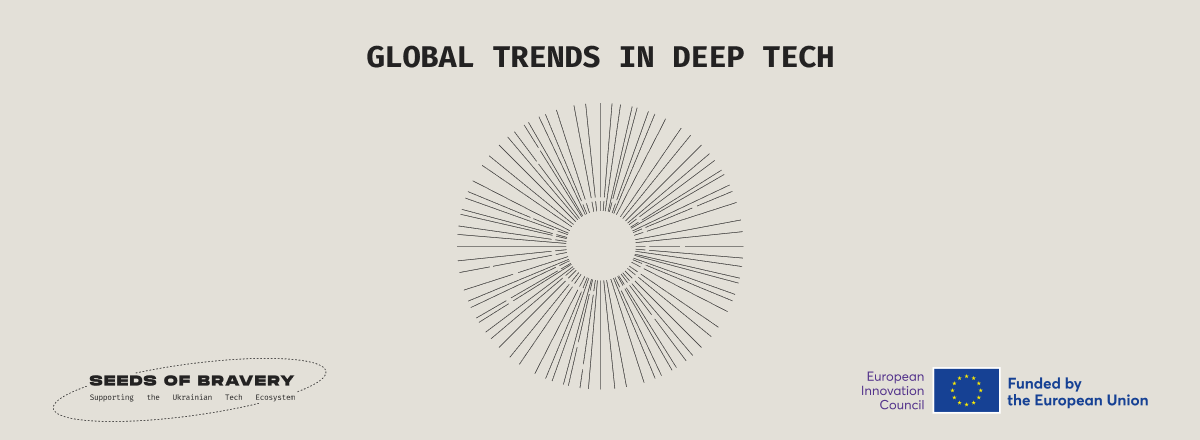Global trends in deep tech

In October 2023, the European Innovation Council (EIC) published the EIC Tech Report 2023, an analysis of global trends in Deep tech and their funding programs. This analytical report is intended to inform about technologies and engineering that have the potential to create transformational solutions and can address the most pressing societal challenges within the framework of the global economic paradigm shift, in the context of the development of deep technologies.
Among the key technologies in DIGITAL, INDUSTRY & SPACE, special attention is focused on the following:
- Advanced materials (e.g., dental & medical implants, engine parts, 3D printing of food, electrocatalysts without CRM, advanced materials for photovoltaic (PV)).
- Artificial intelligence. The ability of AI to develop cognitive attention, foresight, imagination, and perspective that allow symbiotic interaction with external systems. Better understanding of the interaction between smart technologies and human-centered self-aware AI systems.
- The next generation of electronic devices and materials based on 3D interconnects, metadevices (e.g., adjustable lenses for antennas or 3D components that change over time, contactless tactile devices, etc.) The development and implementation of this type of device could open up a wide range of applications in robotics and medicine, as well as usher in a new era for telecommunications. Liquid memory (the use of colloidal nanoparticles for low-cost, high-density memory (over 100 Gbit/mm2) and next-generation photonic integrated circuits, sensors combined with AI for use in difficult environmental conditions (e.g., underwater optical wireless communication) - all this creates an innovative Deep Tech foundation for revolutionary changes in all industries, without exception.
- Measurement systems (environmentally friendly and compact particle accelerators) and Quantum technologies (new qubits - powerful smallest data storage units in quantum systems, room temperature quantum devices, energy-efficient secure quantum communication, quantum sensors and software) allow us to move from classical computing systems to quantum ones.
- Space. Active removal and recycling of space debris. The use of magnets, de-orbit mechanisms, nets, harpoons, cables, space lasers, and solar sails. The most promising green and affordable concepts are tethers, space lasers, and solar sails. In the long term, there will be concepts for recycling in space and reusing rocket bodies, non-existent satellites, or fragments of old satellites. The design and development of de-orbit technologies, such as tethers, solar sails, space lasers, light sails, aerobraking, or atmospheric-breathing electric propulsion (ABEP), will contribute to the emergence of revolutionary, game-changing fuel-free technologies.
CLEANTECH technologies cover such industries as agri-food, construction, energy storage, renewable fuels and chemicals, transportation and mobility. Current technological solutions in these areas are proposed to be developed and scaled up with a focus on:
- Aquaculture,in particular, the use of marine microalgae biotechnology for the production of packaging materials ranging from jellyfish biomass to shellfish.
- Climate-resilient crop that absorb more CO2 and photosynthesis with the help of artificial intelligence.
- Reducing the use of mineral fertilizers in crop production improving software and protective equipment, and restoring soil (optoelectronic chips to detect soil contamination or bionic earthworm robots to monitor soil conditions).
- Precision fermentation as a prerequisite for the creation of innovative food products (production of high-value food and feed, as well as inedible materials, from low-quality materials and food waste, increasing milk yields or producing biopolymers on dairy farms from agricultural waste).
- Biomimetic design strategies in the construction of industrial and residential facilities and the use of carbon-neutral/carbon-negative building materials that can reduce carbon emissions during their use and/or production, as well as increase the carbon capture capacity of materials containing living cells (mycelium).
- Metal-air and flow batteries and new materials for thermal energy storage.
- Waste heat utilization and energy harvesting. Promising areas of research in this area include energy harvesting from ambient moisture, mechanical vibrations, ambient heat, or indoor light.
- Conversion of solar energy into fuels and chemicals using biotechnology, which allows for the creation of a wide range of products, from hydrogen to synthetic fuels or pharmaceuticals.
- Direct carbon capture and conversion as part of the transition to circularity with waste as a resource for renewable fuels and chemicals. New approaches are aimed at converting waste, such as wastewater or flue gas, into a resource that can replace, for example, clean drinking water.
- Intelligent/autonomous high-speed transportation systems and technologies for the development of next-generation road safety systems, including cycling safety prediction models, solar-powered fluorescent road lighting, and advanced driver assistance systems for gentle and personalized mobility.
The HEALTH sector as a flagship among industries in the context of the use of innovative technologies, in particular, was not left without attention:
- The development of metabolic magnetic resonance imaging, which is likely to improve/substitute traditional anatomical images using MRI and other methods.
- The use of ultrasensitive ultrasound for treatment and visualization.
- The use of human-centered robotic surgery based on AI decision-making.
- The emergence of ultra-small and efficient implantable devices that can support a range of functions, including assistance with communication, movement, etc.
- Moreover, biotechnology in the field of disease modeling opens up new opportunities for the development of therapies, including cancer treatment, and includes, among other things, the production of patient/organ tissues.
Analytical materials and articles by leading experts in the fields of DIGITAL & INDUSTRY, CLEANTECH and HEALTH allow you to dive deep into the most promising areas in the context of each industry, for example, quantum technologies (quantum sensors, software, new qubits and hybrid computing) as the basis for the transition of European innovations from the laboratory to the factory environment (from lab-to-fab); the latest materials and devices that help reduce energy consumption, advanced technologies in the field of space exploration, developments for the transition from fossil fuels to fuels derived from renewable energy sources. In addition, there is a high potential in the study and implementation of new technologies for the detection and treatment of cancer.
The full version of The European Innovation Council Tech report 2023 is available here https://eic.ec.europa.eu
